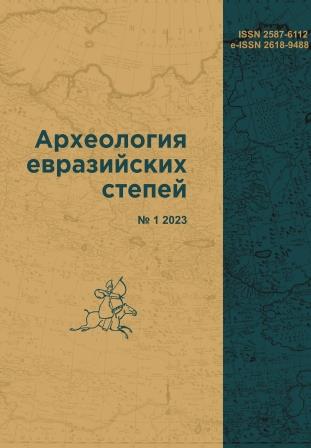Orientational Features of the Buried Persons Among the Representatives of the Mohe Archaeological Culture in the Territory of the Western Amur Region
DOI:
https://doi.org/10.24852/2587-6112.2023.1.93.99Keywords:
archaeological culture, Western Amur region, burial rite, Mokhe, secondary burial, primary burial.Abstract
The article deals with orientation in space during the early Middle Ages. The object of study was the funeral rite as a stable sign of archaeological culture. The study of the positions of the buried in the grave within the Troitskaya group of the Mokhe archaeological culture, widespread in the territory of the Western Amur region, showed the existence of different variants. The existence of such variations was considered from the point of view of astronomical and geographical construction of the world picture. The author’s attempt to link orientation with large geographical landmarks did not give a proper explanation for the existence of those variations of giving a body to the earth, provided that a landmark is static in its position. This fact may indicate the dependence of the location of the human body in the grave on the position of astronomical bodies – the Sun. Minor deviations from the prevailing burial tradition are associated with seasonal deviations of the sun's movements in the firmament. The analysis of statistical data obtained from three archaeological sites (Ust-Ivanovsky, Oktyabrsky and Troitsky burial grounds) allows the author to suggest the relationship between the choice of the type of burial and the time of this burial. It is definitely possible to talk about the sacralization of the southern side among representatives of the Mohe archaeological culture. The exception was the Ust-Ivanovsky burial ground, where burials with the eastern and close to it orientation predominate. In addition, the distinctive features in the construction of inter-grave structures, a relatively small amount of ceramic material, the absence of archaeologically intact vessels in the monument and a number of other signs call into question the belonging of the Ust-Ivanovsky burial ground to the Troitskaya mohe group.
References
Alkin, S. V., Feng Ensue. 2006. In Vestnik Novosibirskogo Gosudarstvennogo universiteta. Istoriia, filologiya (Bulletin of the Novosibirsk State University: History, Philology) 5 (4), 132–134 (in Russian).
Bichurin, N. Ya. 1950. Sobranie svedenii o narodakh, obitavshikh v Srednei Azii v drevnie vremena (Collection of Details of the Peoples Living in Central Asia in Ancient Times) 2. Moscow, Lenindrag: Academy of Sciences of the USSR
Volkov, D. P. 2016. In Buyarov, D. V., Kuznetsov, D. V. (eds.). Rossiya i Kitay: Istoriya i perspektivy sotrudnichestva (Russia and China: history and prospects for cooperation). Blagoveshchensk: Blagoveshchensk State University, 29–33 (in Russian).
Volkov, D. P., Duan Guanda, Nesterov, S. P., Wang Leven, Kovalenko, S. V., Bao Shuguang, Savchenko, T. P., Kryuchko E. I., Ge Liping, Shulmin, R. A. 2019. Materialy i issledovaniya rossiysko-kitayskoy arkheologicheskoy ekspeditsii. Vyp. 1: raskopki Ust'-Ivanovskogo mogil'nika mokhe v 2016 godu (Materials and research of the Russian–Chinese archaeological expedition. Part 1: excavations of the Ust-Ivanovka burial ground Mohe in 2016). Harbin: Heilongjiang Zhenmin Chubanshe Publishing House (in Russian).
Gening, V. V., Gening V. F. 1985. In Gening V. F. (ed.). Arkheologiya i metody istoricheskikh rekonstruktsiy 11йKiev: “Naukova dumka” Publ., 136–152.
Derevyanko, A. P., Kim Bong-Gon, Nesterov, S. P., Choi Meng-Sik, Hong Hyun-Woo, Alkin, S. V., Subbotina, A.L., Yu Eun-Sik. 2008. Materialy i issledovaniya rossiysko-koreyskoy arkheologicheskoy ekspeditsii v Zapadnom Priamur'e. Vyp. I. chast' 1: raskopki rannesrednevekovogo Troitskogo mogil'nika v 2007 g. (Materials and research of the Russian–Korean archaeological expedition in Western Amur basin area: excavations of early medieval Troitskoye burial ground in 2007). Daejeon: Institute of Cultural Heritage Publisher
Derevyanko, E. I. 1997. Troitsky Graveyard (Troitskoye burial ground). Novosibirsk: “Nauka” Publ. (in Russian).
Kovychev, E. V. 1981. In Konovalov, P. B. (ed.). Novoe v arkheologii Zabaikal'ia (Recent Information on the Archaeology of trans-Baikal Region). Novosibirsk: “Nauka” Publ., 73–79 (in Russian).
Kryuchko, E. I. 2020. In Berdnikov, I. M., Lokhov, D. N. (eds.). Materialy LX Rossiyskoy arkheologo-etnograficheskoy konferentsii studentov i molodykh uchenykh s mezhdunarodnym uchastiem (Materials of the LX Russian archaeological-ethnographic conference of students and young scientists with international participation). Irkutsk: Irkutsk State University, 206–207 (in Russian).
Kryuchko, E. I. 2017. In Kenig, A. V. (ed.). Sovremennye problemy izucheniya drevnikh i traditsionnykh kul'tur narodov Evrazii: materialy LVII Rossiyskoy (s mezhdunarodnym uchastiem) arkheologo-etnograficheskoy konferentsii studentov, aspirantov i molodykh uchenykh (Surgut, 17–21 aprelya 2017 g.) (Contemporary issues of the study of ancient and traditional cultures of Eurasia: materials of the students, postgraduates and young scientists LVII Russian (with international participation) archaeological and ethnographic conference (Surgut, April 17-21, 2017)). Surgut; Novosibirsk: Siberian Branch of the Russian Academy of Sciences, Institute for Archaeology and Ethnography, 221–222 (in Russian).
Podosinov, A. V. 1999. Ex oriente luxl Orientatsiya po stranam sveta v arkhaicheskikh kul'turakh Evrazii (Ex oriente luxl Orientation to the countries of the world in archaic cultures of Eurasia). Moscow: “Yazyki russkoy kul'tury” Publ. (in Russian).

Downloads
Published
How to Cite
Issue
Section
License
Copyright (c) 2023 Е. I. Kryuchko

This work is licensed under a Creative Commons Attribution-NonCommercial 4.0 International License.







